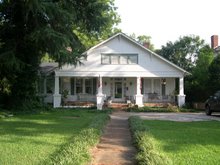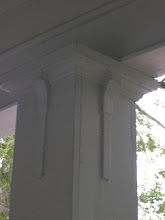I found this here and I thought I would share. I highlighted my pet peeves.
Dr. Luce’s Basic Prescriptions for Preservation!
10/13/2005
1. The buildings, landscapes, and sites created by people who lived on this land before we did can enrich our lives through beauty, education, and economics. Therefore, do as little as possible to change what they left. Change for change's sake, like that done on many TV shows about old buildings, destroys more than it enriches.
2. Don't tear down an historic building (over 50 years old) unless there is no way to avoid it. RE USE IT! Once its gone, its gone, and a photograph is a poor substitute for the real thing.
3. Don't dig for Indian, Civil War, or historic artifacts unless you are qualified and obey all laws, including getting permission from the landowner. Taking goodies from an archaeological site without recording how they relate to one another destroys most of the information in the site. It is like burning a page from a history book that no one has read yet.
4. First things first. Be sure to stop water from getting into a building before you worry about restoring interior decorative items.
5. Don't sandblast anything--ever!
6. Keep as much historic material as possible.
7. Don't remove any good plaster or other historic materials to create a new trendy (well almost trendy) look like exposed brick.
8. Be careful about windows; they are the eyes of the building and small changes can have major impacts. Repair them when possible; replace them only when absolutely necessary. Don't make your building wear sunglasses by tinting its windows.
9. Don't put awnings or shutters on all old buildings. Follow what was originally there. Don't put too much "make-up" on your building.
10. Let your building be proud of its age. Don't try to make it look younger or older than it is. Over-replacement of materials can cause your building to lose its historic appearance and look like a person with a too tight face-lift. On the other hand, inappropriately trying to make your building look older than it is, so that it will fit in, may lose some of its youthful exuberance and look like a teen-ager in ill-fitting, geriatric clothes.
11. Don't try to take a building back to a particular point in time. Historic additions are part of a building's history and are often as important as the original part of the building.
12. Make new work slightly different than the historic. Not only will this prevent confusion about what is old, but it will give you credit for your work.
13. Don't sweat paint color or other reversible procedures. Suggest a possible pallet for people who would like to paint with appropriate colors.
14. Don't paint unpainted brick. Not having to paint brick is one of its major advantages and once you paint it you have to keep painting it. If you ever want to later remove the paint it will take more time and money than you want to spend to remove it without damaging the brick.
15. The landscaping surrounding a building or site provides an important setting. Learn what is there and then prune and add to it rather than bulldozing everything and starting over. Seek plants that are native and drought resistant rather than trees, like Bradford Pears, that can later self-destruct.
16. Develop plans and guidelines for your historic neighborhood or commercial district. Such guidelines can help owners be good neighbors by helping preserve their historic neighborhood. Such plans should include guidelines for new construction, as well as for existing buildings, and should be based on what is in your town, not on some idealized neighborhood.
17. Keep as much as possible of your city's plan - it is as important as its buildings. Respect the size, scale, and relationship of existing buildings. When designing a streetscape, start with what is already in your town, not something from another city or Main Street in Disneyland.
18. Be careful when you dig or excavate. Remember there can be great archaeological sites in cities as well as in the country.
19. These are general prescriptions. For more specific prescriptions (especially when seeking tax benefits or meeting criteria for other programs) see: http://www.gashpo.org/ or www.cr.nps.gov/hps/tps/tax/rhb/stand.htm
Tuesday, September 23, 2008
Prescriptions for Preservation
Subscribe to:
Post Comments (Atom)











4 comments:
fascinating
i luv that you found this and shared it
Thanks Craftsman Girl.
jenni
If only everyone paid attention. Sigh. I'm so glad you posted that.
Numbers 8 and 10/11 (they're pretty similar) are my hobbyhorses. Windows are so important (and expensive to replace, to boot!) and, maybe it's new agey of me, but I prefer to believe that the house has lived a life previous to our ownership and that its history-- the changes it's been through-- are worth respecting.
Unless those changes were, to be frank, stupid. Then there's room for negotiation.
Post a Comment